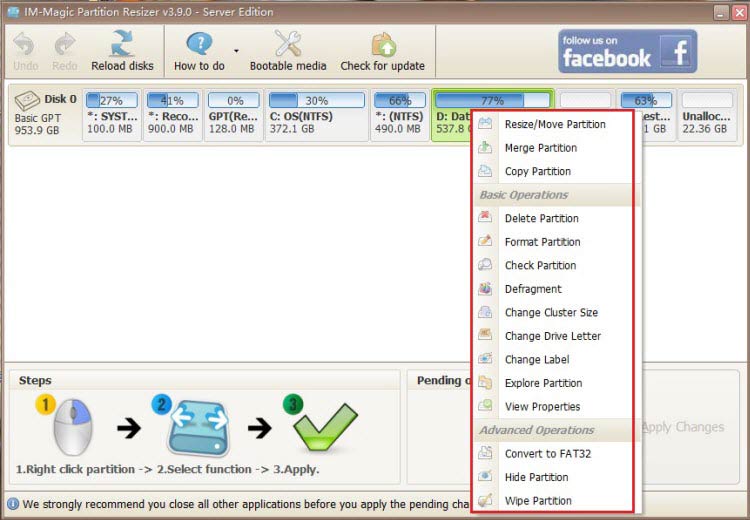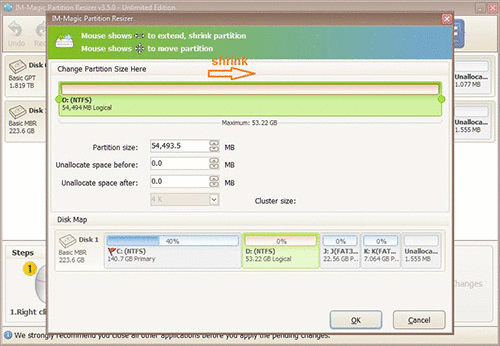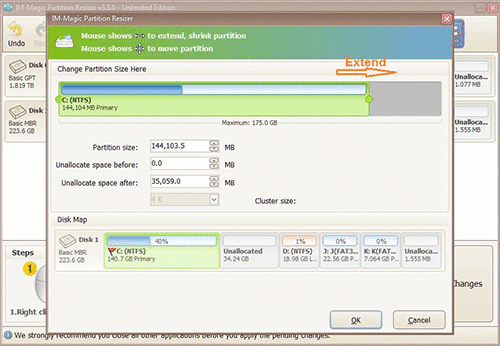Free to resize partition with cmd diskpart on Windows 11/10/8/7/Server
Summary
This article is about how to resize partitions using diskpart command or powershell to change the drive size, or modify the disk volume schedule safely even the boot os system drive with a free tool Partition Resizer.
Table of Contents
- Part1: Resize(shrink/extend) partition with cmd diskpart [Diskpart cmd or Powershell]
- Part2: How to resize partition without data loss with free tool [Partition Resizer]
This following table shows what Diskpart cmd can&cannot.
Note: When mentioning resize partition, diskpart.exe can shrink an ntfs volume.
| Diskpart [FREE] | Partition Resizer*[FREE] | |
| Shrink ntfs partition |  |
 |
| Shrink fat32 partition(any drive) | NO |  |
| Extend ntfs C drive |  YES when right unallocated space is available YES when right unallocated space is available |
 |
| Extend fat32 partition |  YES when unallocated space at right side YES when unallocated space at right side |
 |
| Extend fat32 C drive | NO |  |
| Move unallocated space or partition | NO |  |
| Price | FREE | FREE |
| Download Win 11-7 (100% Free) Download Win Server (Free Demo) |
Note: Partition resizing always requires unallocated space. Whether you use Windows tools or third-party software, ensure unallocated space is available before resizing.
Partition Resizer is a free tool provided by developer IM-Magic Inc. Visit their website at https://www.resize-c.com.
Quick Question: How can I shrink a FAT32 partition?
Answer: The free tool Partition Resizer can help you shrink a FAT32 drive without losing data.
FAT32 or NTFS? How can you identify whether your drive uses FAT32 or NTFS?
- Open This PC or My Computer.
- Right-click the drive and select Properties from the context menu.
- Check the File System column to see if it is FAT32 or NTFS.
Part 1: Resize Partition with CMD DiskPart
DiskPart is a command-line utility that can manage partitions. Here's what it can do:
- Shrink a partition
- Extend a partition
Limitations of DiskPart CMD:
- It cannot shrink FAT32 partitions.
- It cannot move partitions.
- It cannot move unallocated space.
Shrink Partition Using DiskPart CMD (NTFS Partitions Only)
Follow these steps:
- Press Win+R, type
CMD, and press Enter to open the Command Prompt. - Type
diskpartand press Enter. - Type
list volumeto display all volumes. - Select the target volume by typing
select volume *, where*is the drive letter (e.g.,select volume E). - Shrink the volume by typing
shrink size=10240(where10240represents 10GB). Adjust the value based on your needs. For example, for 15GB, useshrink size=15360. - Type
exitto finish.
What Can You Do with Unallocated Space?
- Create a new volume in the unallocated space.
- Clone a partition to the unallocated space (ensure the unallocated space is at least as large as the source partition).
Limitations: DiskPart cannot move unallocated space to a different position. For example:
Example 1: C, D, (Unallocated Space), E, F — DiskPart cannot move the unallocated space next to C, E, or F.
Example 2: C, (Unallocated Space), D, E, F — DiskPart cannot move the unallocated space created by shrinking C to D, E, or F.
Delete Volume Using DiskPart to Create Right-Side Unallocated Space
If you need unallocated space directly to the right of your target drive, follow these steps:
- Press Win+R, type
CMD, and press Enter. - Type
diskpartand press Enter. - Type
list volumeto display all volumes. - Select the volume to delete by typing
select volume *(e.g.,select volume D). - Type
deleteto delete the volume and create unallocated space.
Once the unallocated space is available next to C (if C is an NTFS drive), you can use the DiskPart extend command to expand it.
Also read: How to Move Unallocated Space
Extend Volume with DiskPart CMD (NTFS Drives, Non-C FAT32 Drives)
Extending a drive using DiskPart is possible if there is unallocated space available directly to the right of the target volume.
Note: DiskPart cannot extend the C drive if it is FAT32. (Partition Resizer can help.)
Steps to extend an NTFS drive:
- Press Win+R, type
CMD, and press Enter. - Type
diskpartand press Enter. - Type
list volumeto display all volumes. - Select the target volume by typing
select volume *(e.g.,select volume E). - Type
extendto add the unallocated space to the selected volume.
Note: By using the extend command, DiskPart will automatically allocate any available unallocated space to the selected volume.
Part2: Resize partitions with free partition software
IM-Magic Partition Resizer is an useful free tool that can do many disk management jobs such as shrink drive without losing data, extend drive without losing data (including NTFS&FAT32 drives, c drive), move unallocated space from here to there without losing data, move partition without losing data, clone disk, backup partition, convert disk drive from ntfs to fat32 without losing data, repair disk bad blocks etc.
If you right-click a partition in Partition Resizer, you will see the following options. Details may vary depending on the volume properties.

Video: How to resize partition with Partition Resizer without losing data
For Windows 11/10/8/7 => Download Partition Resizer Free [100% Free]
For Windows Server 2025-2003 => Download Partition Resizer Server [Free Demo]
More video guide here: https://www.resize-c.com/video/
Instructions to resize partitions with IM-Magic Partition Resizer
1, Shrink ntfs or fat32 drives without losing data, even for the c drive with the following steps
- 1, Right click c drive or any drive you want to shrink in Partition Resizer, go to 'Resize/Move Partition' in the right click pop up window
- 2, Move the border of the drive left or right depending on where do you want your unallocated space to be produced, for example, if you want to shrink D dirve and make the unallocated space to be produced right after c drive, you may move the left border of the D drive right forward, and click OK
 Steps to resize partitions in Windows server
Steps to resize partitions in Windows server
When you have unallocated space on the disk, you can extend the disk partition then.
2, Extend a drive (NTFS&FAT32, including the c drive) without losing data with the following steps.
- 1, Produce unallocated space if no unallocated space is available by shrinking a large drive that you may right click the large drive, and go to 'RESIZE/MOVE PARTITION', and then narrow its border to produce the unallocated space
- 2, Right click the partition if it stands between the unallocated space and the unallocated space
- 3, Right click the target partition and go to 'RESIZE/MOVE PARTITION' to extend it by claiming the unallocated space
 Steps to resize partitions in Windows server
Steps to resize partitions in Windows server
Finally, apply the changes.
Also read: how to shrink d drive extend c drive
More Related Articles You May Like
Related Product
- IM-Magic Partition Resizer Server - Partition space redistributing software that works for Windows Server 2003-2025.
